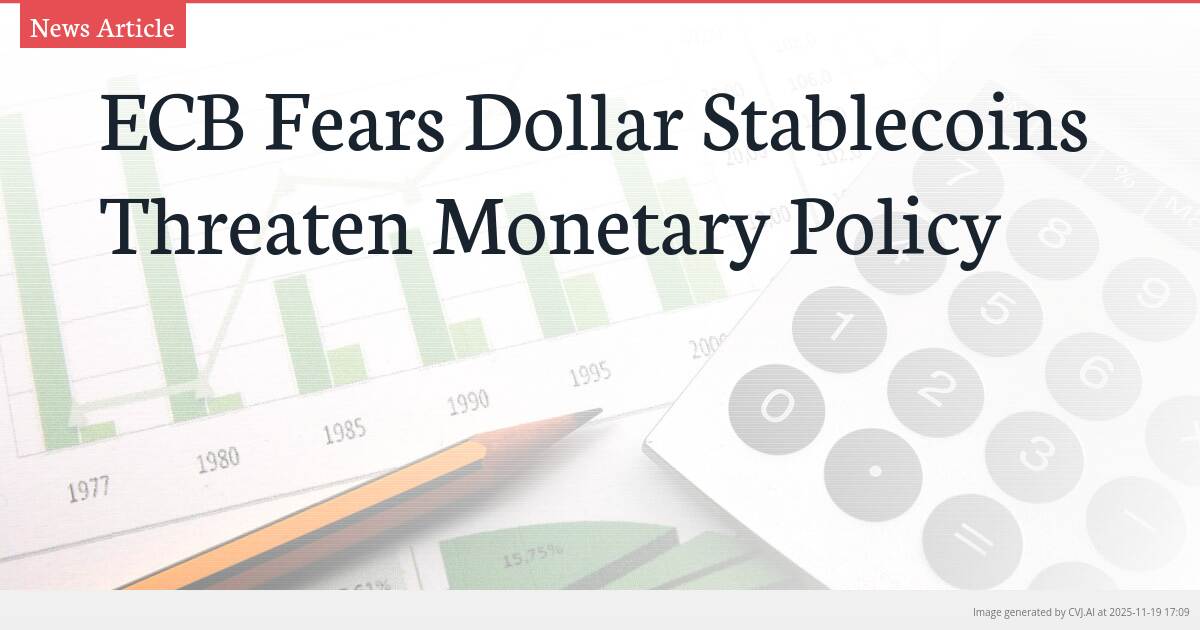Introduction
The European Central Bank is raising alarms that US dollar-backed stablecoins could undermine its monetary policy effectiveness. European issuers share concerns but doubt current solutions like a digital euro can address the challenge quickly enough. The stablecoin market’s rapid growth is creating new vulnerabilities for traditional financial systems.
Key Points
- ECB officials believe dollar stablecoins could constrain their ability to implement effective monetary policy during financial crises
- Stablecoin market capitalization continues reaching new monthly highs, driven largely by US regulatory clarity
- European stablecoin issuers doubt that digital euro proposals can provide a timely alternative to dollar-dominated stablecoins
The Dollar Dominance Dilemma
Central bankers at the European Central Bank are confronting an emerging threat to their monetary sovereignty: the explosive growth of US dollar-backed stablecoins. As the stablecoin market continues hitting monthly all-time highs in capitalization, ECB policymakers are growing increasingly concerned about what this dollar-denominated digital asset proliferation means for Europe’s financial stability. The core issue lies in the potential erosion of the ECB’s ability to implement effective monetary policy, particularly during times of financial crisis when traditional policy tools become most critical.
The stablecoin market boom over the past year has been largely driven by legal certainty in the United States, creating a regulatory environment that has accelerated adoption of dollar-pegged digital assets. This regulatory clarity has positioned dollar stablecoins as the dominant force in the cryptocurrency market, raising alarms among European monetary authorities who see their policy influence potentially being diluted by these privately-issued dollar instruments. The concern extends beyond mere market share—it touches on fundamental questions about who controls monetary conditions within the European Union.
Crisis Response Capabilities at Risk
ECB officials specifically worry about how increased adoption of dollar-based stablecoin assets could constrain their crisis response capabilities. During financial emergencies, central banks typically rely on their ability to influence interest rates, control money supply, and provide liquidity to stabilize markets. The proliferation of dollar-denominated stablecoins creates a parallel monetary system that operates outside the ECB’s direct control, potentially limiting the effectiveness of traditional policy interventions when they’re needed most.
The concern is particularly acute given the stablecoin market’s relentless growth trajectory. With each month marking new record highs in market capitalization, the scale of these dollar-pegged digital assets is becoming significant enough to meaningfully impact monetary transmission mechanisms. European policymakers fear that in a crisis scenario, market participants might flock to dollar stablecoins as safe havens, bypassing the euro system entirely and undermining the ECB’s ability to manage financial stability within the Eurozone.
European Alternatives and Their Limitations
Issuers of stablecoins backed by the euro and pound recognize these same risks but express skepticism about proposed solutions. While the digital euro has been floated as a potential counterweight to dollar stablecoin dominance, European stablecoin issuers question whether this central bank digital currency can provide a viable alternative quickly enough to address the immediate threat. The development and implementation timeline for a fully-functional digital euro remains uncertain, while dollar stablecoins continue their rapid market expansion.
The debate extends beyond timing to fundamental questions about design and functionality. European stablecoin issuers are questioning whether a central bank digital currency is the right fit for addressing the specific challenges posed by dollar stablecoins. There are concerns about whether a CBDC can replicate the market-driven features and global accessibility that have made dollar stablecoins so successful, or whether it might instead create new complications for the existing financial system.
This skepticism from within the European cryptocurrency industry highlights the complex balancing act facing regulators. They must protect monetary sovereignty while not stifling innovation, and find solutions that can compete with the network effects and first-mover advantages that dollar stablecoins have already established. The challenge is particularly acute given the head start that US regulatory clarity has provided to dollar-denominated digital assets.
📎 Source reference: cointelegraph.com

